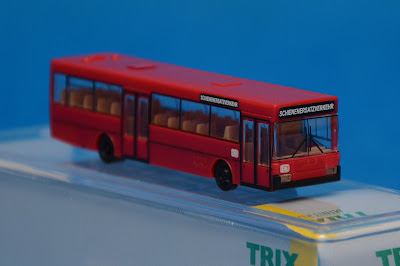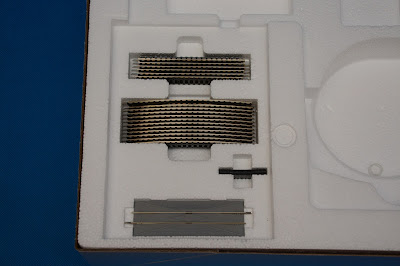For me the main reason to buy this item was its DCC central station. I needed one more controller for my coffee table layout and - being a long-time Fleischmann/Roco user - I decided to give the competition a chance this time. Trix 11140 was the most economical way to get it (considering all the extra stuff I got).
Let's take a look at the product. The side of the packaging shows all the basic information about the set. It is digital, it features sound effects, the locomotive offers white headlights and red taillights, and so on... and so on...
Another picture shows the content I'm going to find inside: a passenger train, a digital controller kit, an oval track set...
...and a bus model. A bus model? Interesting...
Let's open it already. Here's what was revealed to me right after lifting the lid of the box.
The product comes with a lot of documentation. Even the AC adapter gets its own small booklet.
The most interesting one is of course the locomotive description. Here we can learn that the model features an impressive number of 28 DCC functions.
There's also a guidebook included which attempts to describe the most important aspects of our hobby. I have not read it, yet, but I must say it does look promising. It might actually be useful for someone just starting his/her adventure with the trains.
The central station's manual is written very clearly with a lot of pictures and screenshots. For some reason I got two French copies of the text, and not a single English one. Well, I can't say I really care - it's all available online anyway.
This is what the content of the box looks like once I removed all the books and leaflets.
For me the most interesting part of the set is the digital controller kit. It consists of three elements: Trix 66955 mobile station (the controller), a connector box and a power supply.
Let's power it up. "Keine Lok" is the welcome message - obviously the device is not configured, yet.
This is where it gets interesting. Included with the set is a chip card containing information about the featured locomotive.
Once you slide the card into the mobile station, the data is read and the controller immediately becomes ready for operation. The DCC functions are configured automatically and the relevant icons show up on the screen. The programmed engine's image does not really resemble the model at all, but luckily it's something that can be changed manually.
What worries me more is the limitation of the controller. It seems to be able to access only the first 16 DCC functions of the decoder. So while the locomotive features more, I won't be able to use them all. That's a little concerning...
The language used on the mobile station can be changed easily. And a nice surprise here - it even features Polish!
My overall feeling about the Trix digital station is the following: it is simple, it is comparable to Roco Multimaus, but is definitely less than Roco z21. All in all, it should be fully sufficient for my coffee table layout.
But enough about the mobile station. At the very bottom of the box I found this little bag. I'm not sure what the content really is, but those strips look like power pick-ups for the passenger cars. I'll investigate it later...
Let's take a look at the locomotive now. It comes separately packaged...
...and again the side of the box lists all the main features.
Here's the model itself. It's a BR146.2 electric engine in red Deutsche Bahn livery.
It definitely looks simple with very few significant details, and almost no separately applied parts.
The pantographs however can be raised...
...and if you look closely, you'll notice it is very nicely painted indeed. It's definitely a budget model, but it will do very well inside my coffee table :)
Let's move onto the passenger cars...
The first impression - they feel light. And of course in this hobby "light" means "cheap". But did we expect more?
They don't look bad though, they're nicely painted and even feature some interior details.
But in the end the quality could be better. In my case, the roof on one of the cars was not even properly attached to the body. I'll have to fix it somehow...
Obviously they don't come "interior lighting ready". But those wheels look like they would accommodate the metal strips mentioned above really well.
OK, it's time for the last element - the bus model.
This one feels really cheap. It's very, very light and it's made purely of plastic. Still, it does look reasonably well and can definitely be used on a layout. Considering it's a free extra - I like it!
And a surprise. This little bus model can be customized! If you disapprove the wheels in a straight position, you can replace an axle and the wheels' angle will change. That's cool!
The set features a selection of track pieces, which I will not be describing. My coffee table layout is going to use Kato Unitrack anyway, so the elements from the Trix package are staying inside the box. Maybe one day I will find some use for them.
Alright, as always - let's take a look at the digital performance of the locomotive. Here's a short video I created:
Well, the DCC functions on this model are not bad at all. They are actually on par with the fully priced engines. That's a very nice surprise!
Summary
Trix 11140 starter set is definitely some sort of a compromise. The locomotive is simple, the quality of the cars is not what we're used to, and the bus model is just a toy. But we have to remember that we get all of that - plus the digital controller, plus the sound functions, plus a set of track - at a cost of a single regular engine. So it is still an amazing deal, and a great way to make a start in the hobby.
While I can't suggest purchasing this set to people who expect perfection and care about every single detail, I can definitely recommend it as a cost-effective way to begin your adventure with trains. Or - as in my case - a way to get a controller and an extra locomotive that can be run by your family members or guests without causing you much of a headache.































Nice simple and same time somehow deep review, just bought one myself for command station and budget price. Thnx.
ReplyDeleteThanks for aking the time to write this detailed review. It helped me make the decision to get this set to get the necessary digital parts for an old, analog Fleischmann track I am reviving, plus I can rip out the DCC+sound unit to be transplanted into a Luxemburgisch, similar, locomotive. Your coffee table project is not a bad idea either… Dutch greetings to you !
ReplyDelete